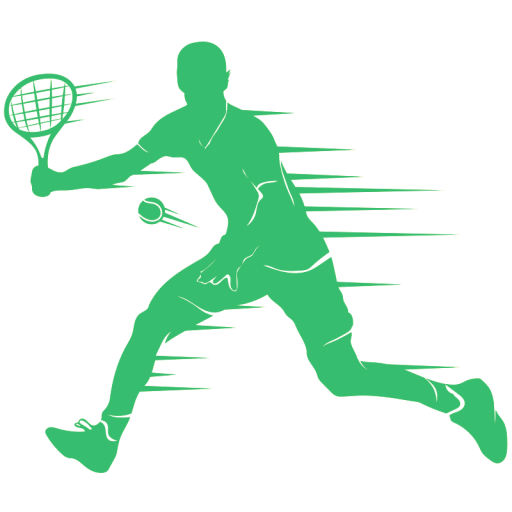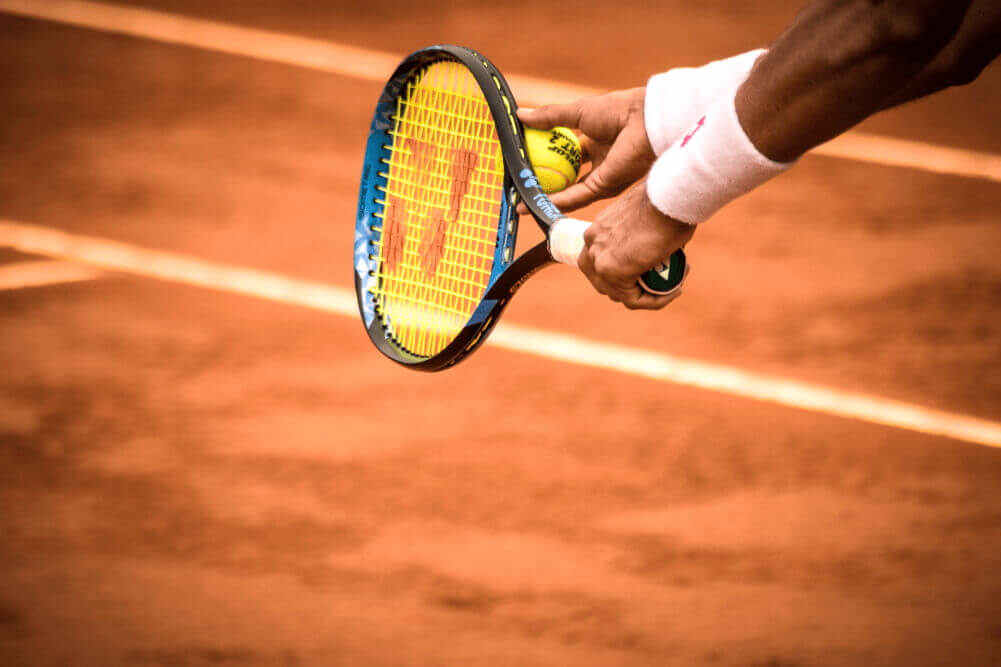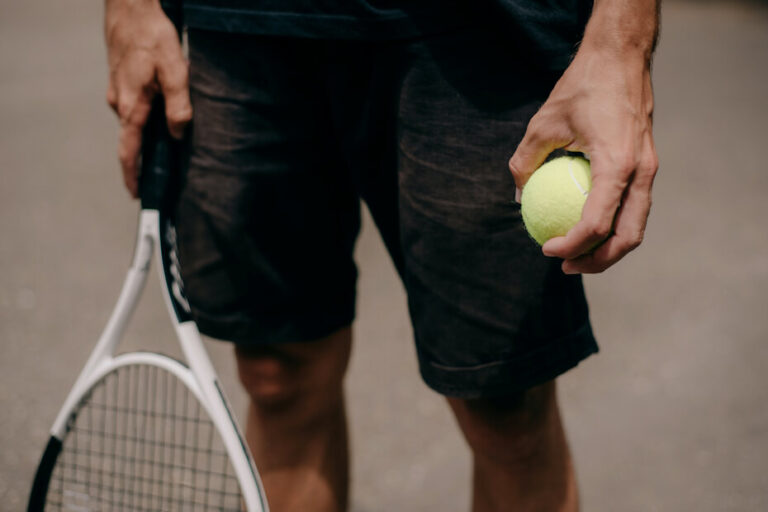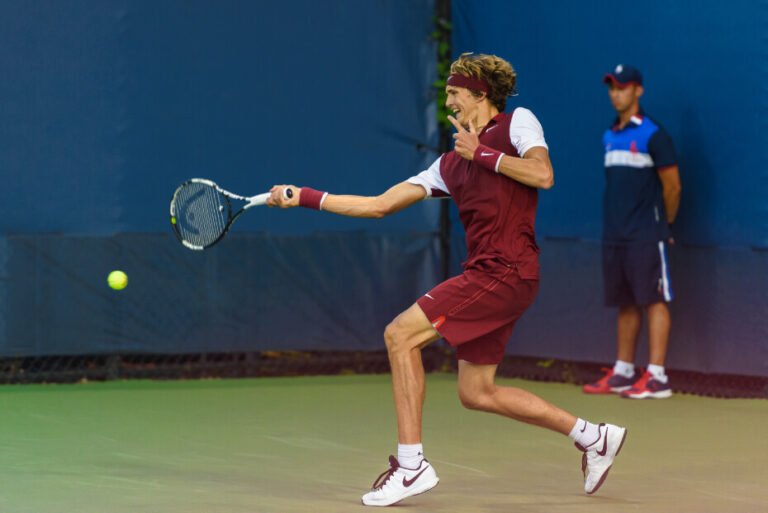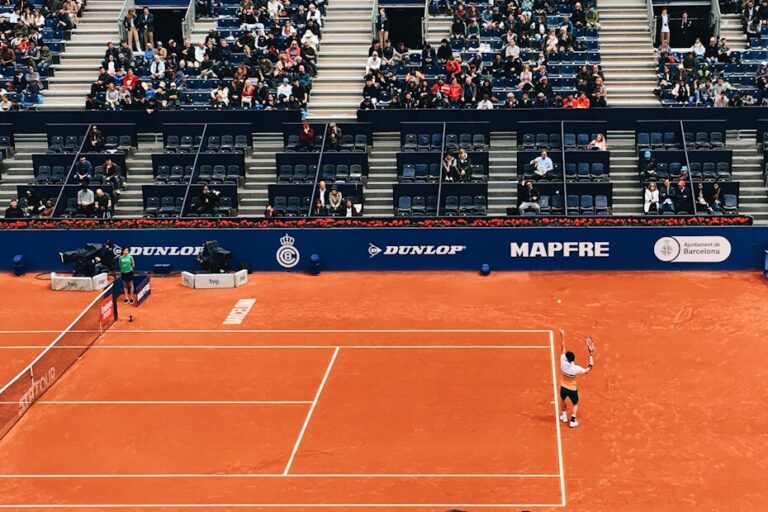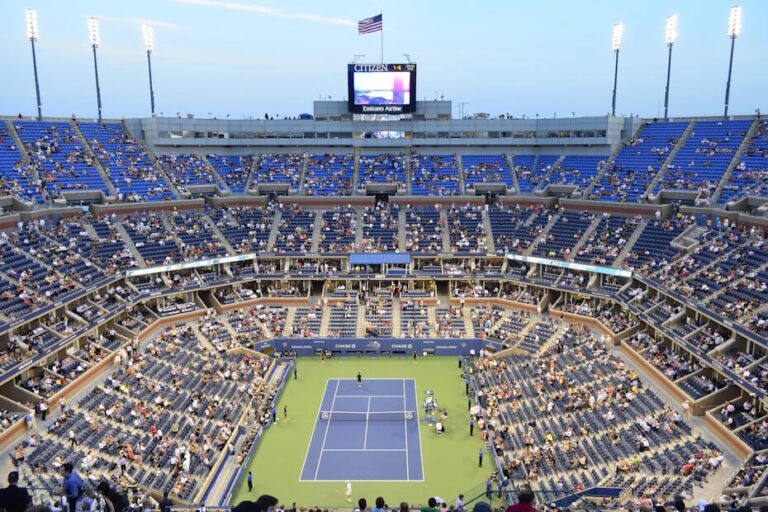Tennis is a fantastic sport to watch, but it is also a wonderful sport to play. Not only can playing tennis help you to lose weight and tone your muscles, but it will also improve your cardiovascular fitness and mobility, and help you to have fun and enjoy yourself.
If you’re considering playing tennis, or even if you simply want to learn more about this wonderful and noble sport, it’s important to not only familiarize yourself with the rules, but also you must ensure that you familiarize yourself with the terminology too.
Tennis, like any other sport, has its own terminology and if you don’t understand the jargon this will, of course, affect how you play, understand, and ultimately, enjoy this amazing game.
So, in no particular order, and to help you understand your aces from your deuces, here’s a comprehensive look at some basic tennis terms you need to know.
Lob
If you hear people talking about a lob shot in tennis, this is basically a shot that the player hits with any stroke deep and high into their opponent’s side of the tennis court.
Although a lob can be used anytime during a match, more often than not you’ll find tennis players using a lob shot when their opponent is standing close to the net. Here, the ball is literally ‘lobbed’ over their head and will hopefully bag you the point.
Drop
Want to get good at tennis? If so, you need to know how to perform a drop shot. Before you can perform a drop shot, you first need to know what one is.
Basically, a drop shot is a shot that is very soft and is designed to be hit just over the net. Drop shots can be used to score a point if your opponent is standing at the far end of the court away from the net, or you can use the shot to draw your opponent close to the net so you can hit the ball over them and hopefully grab a point that way.
Backhand
A backhand isn’t something that your parent’s used to give you as a child when you stepped out of line, it is instead a type of tennis shot.
A backhand is used to describe a shot performed by the non-dominant side of your body that you ordinarily would not use to perform a tennis shot.
If for example, you are left-handed, your backhand side would be the right side of your body, and vice versa if you were right-handed.
Forehand
A forehand is a shot that is played when the palm of the player’s dominant hand happens to be facing forwards.
So, if for example, you are left-handed, a forehand shot would be a shot that you play on the left side of your body and vice versa.
Serve
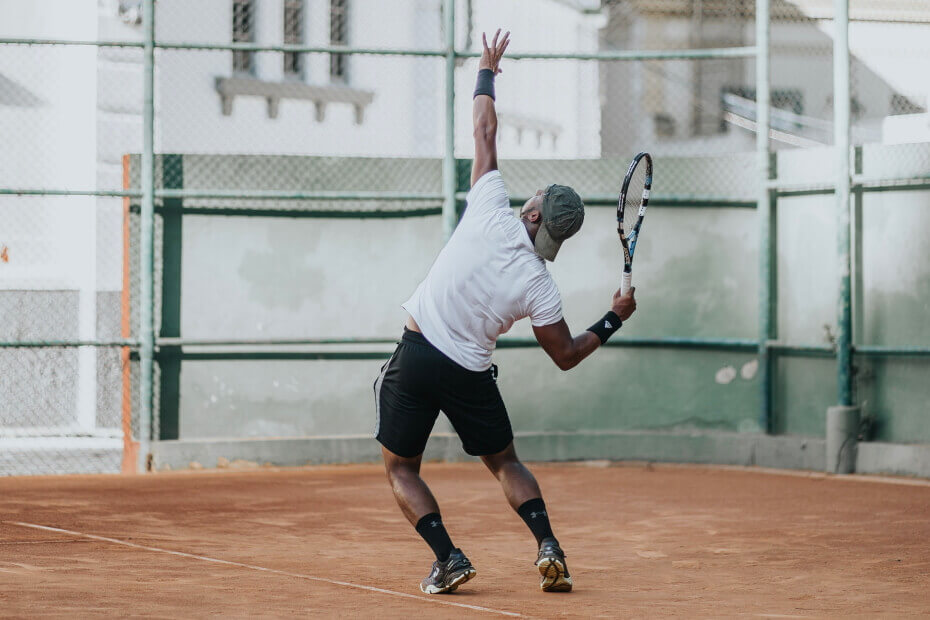
A serve, also known as ‘service’ is very important because this begins active play.
Players will begin by serving the ball, usually with an over-the-arm stroke from behind the baseline into the service box of their opponent.
Per point, players have two serves, known, very simply, as first serve and second serve.
Overhead
During match play, you may be required to hit an overhead shot, but what exactly is this? Well, you can probably guess the position that the shot is played, but what exactly does the shot entail?
Basically, an overhead shot is one that is hit over your head (surprise, surprise) either on the fly or after the ball has bounced once.
Some tennis players refer to the overhead as a ‘smash’ due to the amount of power that the shot can generate. While overhead shots aren’t always the prettiest of tennis shots, they’re extremely effective if hit correctly.
Drop Volley
Another important shot to master in tennis is one known as the drop volley.
We’ve looked at a drop shot, but what about a drop volley? Well, basically, a drop volley is a drop shot that is performed at the netting before the ball bounces.
Spin
This is pretty self-explanatory really but just to ensure that there isn’t any confusion, when a player hits a ball and they put a spin on it, it generally lands and bounces awkwardly, making it much harder for the opposing player to deal with.
Ace
Next up we have the ace. No, we’re not talking about a set of playing cards, we are in fact talking about a tennis serve.
An ace is a serve that the opponent doesn’t even get a chance to strike with the racquet. If a player is serving and they smash an ace, it will land exactly where it is supposed to land and bounce out of play before the returner gets a chance to return the ball, thereby instantly winning the point for the serving tennis player.
Aces are tricky serves to pull off, but when you hit one in that sweet spot and hit it just right, boy, it is satisfying.
Seed
The seed that we’re referring to today isn’t one that you plant in the ground to grow fruits or vegetables, but rather, it is a tennis term used to describe the ranking of a player in a tournament.
Bagel
Not only a delicious, toasted breakfast food but also a term used in tennis.
A bagel is when a doubles team, or a tennis player, fails to secure a win on a single game in a set, or when they score a zero.
Why? well quite simply the symbol for zero is 0 which resembles the same type of circular shape as a bagel. It sounds a little quirky and bizarre, but it’s absolutely true and we love it.
Hopefully the only bagels you’ll ever get will be toasted ones filled with smoked salmon and cream cheese.
Deuce
When it comes to scoring a game of tennis, it’s important to understand terms such as deuce.
Deuce is a score of 40-40 or 40-all. Those familiar with the rules of tennis will know that this means that both players or both sets of players in the event of doubles, will have won at least 3 points with the score being tied.
Advantage
When watching your favorites compete on the TV at the US Open or any other Grand Slam tournaments for that matter, you will almost certainly have heard the officials yelling out ‘advantage’ at some point, but what does it mean?
Basically, an advantage is where a player happens to secure the point at 40-40 or ‘deuce’. Having the advantage means that a player is just one point away from winning the game.
Ad in
Ad in is a term used when the player that is serving secures the point after being tied with their opponent at 40-40, or deuce.
Ad out
Ad out is another important term to understand if you want to master your knowledge of the awesome game that is tennis.
Ad out is a term used when the returning player happens to secure the point after having been tied with their opponent at 40-40, or deuce.
All
All is a very simple term to remember as it is basically used to describe an even score. So, for example, if the score is 15-15, it would be 15-all.
Let
If you ever heard the word ‘let’ used in tennis, this is a term used when the serve of a player happens to strike the netting, but still, makes it over into their opponent’s half of the court and falls within the appropriate service box.
If a point is interrupted by any outside interference, a let is also called.
If a let is indeed called, this means that a point must then be replayed.
Fault
A regular fault will occur when a player’s serve lands out of bounds, hits the netting, or when they commit a foot fault like we just looked at.
Players are permitted one fault, hit two, and this will be a double fault.
Double Fault
A double fault takes place when a player has committed two faults. Hit a double fault, and the serving player concedes a point.
Foot Fault
If you want to master your serve during a game of tennis you need to make sure that you stamp foot faults out of your game.
Foot fault is a term used when a serving player’s foot, or any other part of their anatomy, happens to touch the center line or the baseline when they are performing their serve.
When a player commits a foot fault on their second serve attempt they automatically lose their service attempt as this is a double fault.
ATP
The ATP, also known as the Association of Tennis Professionals, was founded back in 1972. If you know your tennis, you will have heard of the ATP as this is the primary governing body of professional men’s tennis.
The ATP is stationed in London and it manages and oversees a whole host of different tournaments and events, including the ATP Tour, the ATP Champions Tour, and the ATP Challenger Tour.
Many tennis fans consider tennis to be synonymous with the ATP, and we can totally understand exactly why that is.
WTA
The WTA was founded by Billie Jean King in 1973 and is the women’s answer to the ATP.
The WTA (Women’s Tennis Association) is the primary governing body of professional women’s tennis.
The WTA began representing just 9 players, yet today, it represents over 2,500 female players and has headquarters in London, England, St. Petersburg, Florida, and Beijing, China.
The WTA’s primary objective is to campaign for equal rights for female tennis players, including equal prize money in the Grand Slams, which it achieved back in 2007. This is certainly more than fair considering the fact that some of the biggest names in all of tennis, including Venus and Serena Williams, Martina Navratilova, Steffi Graf, Monica Seles, Chris Evert, and many more, are all females.
Grand Slams
We’ve mentioned Grand Slam Tournaments multiple times today, but just so that there’s no confusion, a Grand Slam, also known as a ‘Major’ is one of the four most important tennis tournaments of the calendar year.
The four Grand Slams are:
- Australian Open
- French Open
- Wimbledon
- US Open
These tennis tournaments are to tennis what the European Championships and the World Cup tournaments are to football/soccer.
These are by far considered to be the largest, most popular tennis tournaments as they attract the most fans, get the most media coverage, offer the most generous prize money, and attract the best professional tennis players in the world.
To win just one Grand Slam is considered an honor and an incredible achievement, to win all four, however, is something only a select few elite tennis players will ever accomplish.
These tournaments use a 128-player draw and are held over 2 weeks. They also happen to be the only tournaments that still happen to play best-of-five sets matches.
It should also be noted that the ATP and WTA do NOT run these tournaments. The Grand Slams are run by separate, autonomous organizations, and work in conjunction with the ATP and the WTA.
Australian Open
The Australian Open is the first Grand Slam tennis tournament of the year and no prizes for guessing where it is held.
The tournament is also sometimes known as the ‘Happy Slam’ or the ‘Grand Slam of Asia Pacific’ because of its sunny weather and energy from the fans, and where it is held, respectively.
Held in Melbourne, Australia, this tennis tournament is a hard surface tournament held each year in January. For most, January is a cold and bleak winter month, but as Australia is located in the Southern Hemisphere, it is instead hot and sunny.
Incidentally, Serena Williams has the most singles women’s titles here having won 7, whereas Novak Djokovic has won the most men’s singles titles here, with 9.
French Open
Here we have the French Open, which is sometimes known as the Roland Garros.
This is the second Grand Slam tennis tournament that takes place each year in the springtime for the Northern Hemisphere.
The French Open takes place in Paris and is a tricky one as this is held on clay. If you’re wondering about the Roland Garros name, this is actually named after a famous fighter pilot during the First World War.
Chris Evert holds the record for the most women’s singles titles here with 7, whereas Rafael Nadal holds the record for the men, with a staggering 13, which is certainly not an unlucky number for the Spaniard.
Wimbledon
Wimbledon is the third Grand Slam tennis tournament of the year as it takes place each year in the summer in the UK, In late June right through until the second week in July.
Wimbledon is a special tournament as it is the oldest tennis tournament in the world and has been played since 1877.
Held at the All England Tennis Club in Wimbledon, London, Wimbledon is an all-grass tournament that many consider being the most popular of all the Grand Slams. It is certainly the one that generates the most attention from the media.
If you want a tournament that embodies everything that the older tennis tournaments used to represent, I.E the requirement for all-white attire, Wimbledon is the tournament for you.
Synonymous with fresh ripe strawberries and cream, along with the typical English summertime weather (grey skies and drizzle) Wimbledon is a Grand Slam tennis lovers cannot wait for.
Roger Federer holds the record for the most men’s singles titles here with an impressive 8, whereas the women’s record is held by Martina Navratilova, with 9.
US Open
Up next, we have another of the big four Grand Slam tournaments, this time the US Open.
This is the final Grand Slam tennis tournament that takes place during the year, as it is held in the Big Apple itself – New York City, at the end of the summer.
Serena Williams and Chris Evert both hold the record for the most women’s singles titles in this tournament, with 6.
For the men, the record is 5, and it is held by Pete Sampras, Roger Federer, and Jimmy Connors.
Junior
If you hear a tennis player being referred to as a junior, this is because they are under the age of 18.
Junior tennis players can compete in international, local, and national tournaments where they will gain experience and improve their rankings. Most junior pros who will eventually go on to become professional tennis players will compete in the ITF Junior Circuit throughout the calendar year.
Each of the four Grand Slam tournaments also features a junior version of the tournament.
Baseline
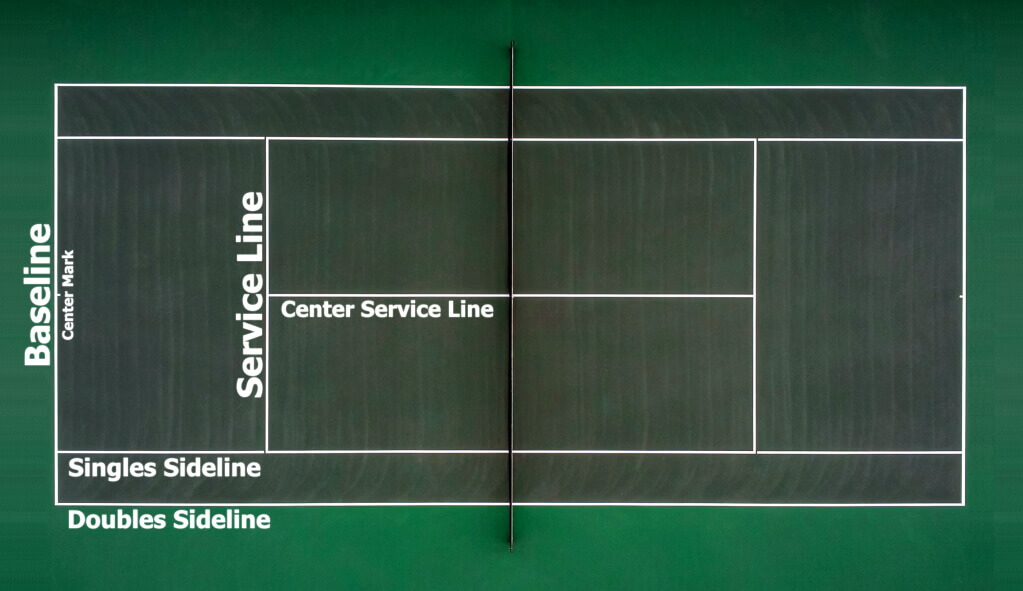
As well as learning about tennis strokes and scoring terms, you also need to learn the court, which is why the term ‘baseline’ is so important.
The baseline is the parallel line to the net which is designed to designate the outer-most edges of the tennis court.
Service Box
The service box is a term used to describe the two boxes located on either side of the net.
During a game of tennis, the server must serve the ball from their side of the court into the service box on their opponent’s half of the court directly diagonally opposite from them.
Alley
The alley is a part of the tennis court between the singles line and the doubles line.
During match play, the alley will only be utilized in doubles, and not in singles.
Line
Finally, we have the line or lines.
The dimensions of the entirety of a tennis court are indicated by white lines.
If a ball bounces on any part of the line, no matter how small it may be, the ball will be counted as being ‘in’.
Cross Court
If a ball travels across from one deuce side of the court to the other, or from one Ad side to the other, it has traveled cross-court, which is why this term is used.
Grip
Your grip is basically how you choose to hold your tennis racquet during a game of tennis. You can select from 4 standard grips, which are:
- Eastern grip
- Western grip
- Continental grip
- Semi-Western grip
Eastern Grip
The Eastern Grip was created by Bill Tilden, though Bjorn Borg, Roger Federer, and Pete Sampras, all used it and really glamorized it.
The Eastern grip enables players to hit hard, flat shots, yet it ensures that they are mobile enough to accommodate any topspin shots that may be required.
Western Grip
The Western Grip, also called the Western Forehand, is an extreme grip that generates a shot that puts a huge amount of topspin onto the ball, causing it to bounce unusually high.
The fact that this grip makes the ball bounce so high means that shots utilizing this grip can be a nightmare during serves.
Continental Grip
The last grip we have today is what is known as the Continental Grip.
This grip is typically reserved for volleys, overheads, and serves, along with two-handed backhands.
This grip is still very effective, yet it has been used for decades, namely by Billie Jean King and Arthur Ash, who actually utilized this grip for every shot, not just the aforementioned ones.
Semi-Western Grip
The semi-western grip has become the most common forehand grip in tennis as it allows for a large amount of topspin, and quick grip changes. It also works very well on grass, clay, and hard courts.
Counterpuncher
No, we aren’t getting confused with boxing, a counterpuncher style of play can actually be utilized during a game of tennis.
If a player is known as a counterpuncher, they play a style of tennis that incorporates very fast and accurate footwork, as well as great accuracy and consistency, along with their opponent’s pace to earn them points by drawing errors from their opponents.
Andy Murray is a very well-known counterpuncher in the world of tennis.
Hawkeye
When watching your favorite tennis pros at Wimbledon, you will likely see the use of Hawkeye, but what the heck is it?
Hawkeye technology is basically a highly elaborate and sophisticated camera replay system that is utilized when tennis players legally challenge calls/decisions made by the umpires or lines people.
If you are familiar with Football/soccer, you may be familiar with VAR (Video Assistant Referee), if so, Hawkeye works on a similar basis to that. Whether you like modern tech in the sport of tennis or not, it does appear to be here to stay, and if used right, it can really enhance a game.
Davis Cup
When people think of tennis tournaments, they tend to focus on the Grand Slams and overlook the Davis Cup, which is actually one of the most prestigious tennis tournaments in the world.
The Davis Cup was first held back in 1900 as a team match between the USA and Great Britain.
It was an international team tennis tournament for men that began to grow and expand as the years ticked by. As mentioned, initially it was a similar principle to the Ryder Cup in Golf, in that it was the USA taking on Great Britain (not Europe like the Ryder Cup). However, more and more nations slowly started to get involved.
Today, there are over 135 nations taking part, with teams made up of professional male tennis players representing their countries. Right now, the USA has won the most titles, having racked up an impressive 32.
The tournament now takes place over one week, yet when it was first created, it would be held throughout the entirety of the calendar year.
Fed Cup
Of course, the men can’t have all of the fun, which is why we also have the Fed Cup in the tennis world.
The Fed Cup is the women’s equivalent to the Davis Cup, as it is the biggest international women’s team tennis competition in the world today.
Each year, teams from all over the globe will compete against each other for the ultimate honor of being crowned Fed Cup winners.
The cup was established in 1963, and at that time, it was known as the Federation Cup. It was then known as the Fed Cup, before being renamed the Billie Jean King Cup back in 2020, to honor the iconic women’s tennis champion and pioneer for women’s tennis.
Again, it is the United States who has bragging rights here, as they hold the most titles with an impressive 18.
